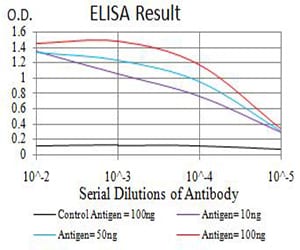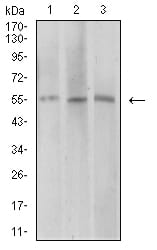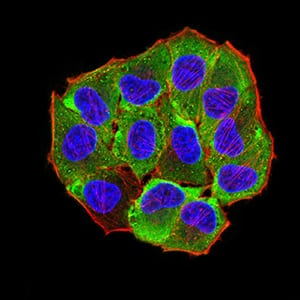


| WB | 1/500 - 1/2000 | Human,Mouse,Rat |
| IF | 咨询技术 | Human,Mouse,Rat |
| IHC | 咨询技术 | Human,Mouse,Rat |
| ICC | 1/100 - 1/500 | Human,Mouse,Rat |
| FCM | 咨询技术 | Human,Mouse,Rat |
| Elisa | 1/10000 | Human,Mouse,Rat |
| Entrez GeneID | 121536 |
| clone | 3E3C10 |
| WB Predicted band size | 54.5kDa |
| Host/Isotype | Mouse IgG1 |
| Antibody Type | Primary antibody |
| Storage | Store at 4°C short term. Aliquot and store at -20°C long term. Avoid freeze/thaw cycles. |
| Species Reactivity | Human |
| Immunogen | Purified recombinant fragment of human AEBP2 (AA: 358-495) expressed in E. Coli. |
| Formulation | Purified antibody in PBS with 0.05% sodium azide |
+ +
以下是关于AEBP2抗体的3篇参考文献及其摘要概括:
---
1. **文献名称**: "AEBP2 as a novel regulator of Polycomb Repressive Complex 2 (PRC2) in genomic targeting"
**作者**: Cao, Q., et al.
**摘要**: 研究揭示了AEBP2作为PRC2复合体的关键调控亚基,通过ChIP-seq实验(使用AEBP2特异性抗体)证明其在H3K27me3修饰和基因沉默中的靶向作用,尤其在胚胎干细胞分化中调控发育相关基因。
2. **文献名称**: "AEBP2 promotes glioblastoma progression through epigenetic silencing of tumor suppressor genes"
**作者**: Su, X., et al.
**摘要**: 通过Western blot和免疫组化(使用AEBP2抗体)发现其在胶质母细胞瘤中高表达,并通过与PRC2相互作用抑制抑癌基因,促进肿瘤生长,提示其作为潜在治疗靶点。
3. **文献名称**: "Antibody-based profiling of AEBP2 in chromatin remodeling and stem cell pluripotency"
**作者**: Kasinathan, S., et al.
**摘要**: 利用AEBP2抗体进行染色质分析,发现其在维持干细胞多能性中的作用,敲除后导致PRC2功能异常及分化相关基因异常激活,强调其表观遗传调控的重要性。
---
以上研究均通过AEBP2抗体探究其在基因调控、疾病机制及干细胞生物学中的功能。如需具体文献链接或更多信息,可进一步提供。
The AEBP2 (Adipocyte Enhancer-Binding Protein 2) antibody is a tool used to study the AEBP2 protein, a transcriptional regulator involved in epigenetic modulation and chromatin remodeling. AEBP2. initially identified for its role in adipocyte differentiation, is now recognized as a component of the Polycomb Repressive Complex 2 (PRC2), which mediates gene silencing through histone H3 lysine 27 trimethylation (H3K27me3). This zinc finger-containing protein binds DNA and facilitates PRC2 recruitment to specific genomic loci, influencing developmental processes, stem cell maintenance, and cellular differentiation.
Aberrant AEBP2 expression is linked to diseases, including cancers, where it may act as an oncogene or tumor suppressor depending on context. Its dual role in transcriptional repression and chromatin interaction makes it critical for studying epigenetic dysregulation in pathologies. The AEBP2 antibody is widely used in techniques like Western blotting, immunofluorescence, and ChIP-seq to investigate its expression, localization, and molecular interactions. Researchers also employ it to explore AEBP2's functional crosstalk with other PRC2 subunits (e.g., SUZ12. EED) and its impact on cellular processes like adipogenesis, neurogenesis, and tumor progression. As epigenetic therapies gain traction, understanding AEBP2's mechanisms via specific antibodies remains vital for uncovering therapeutic targets.
×